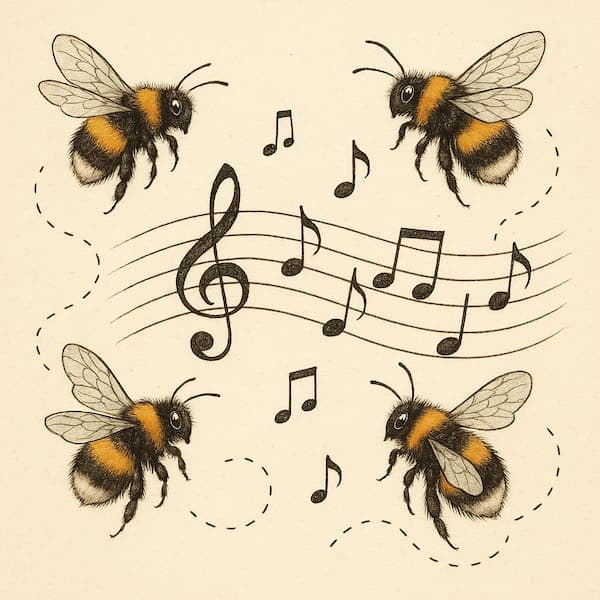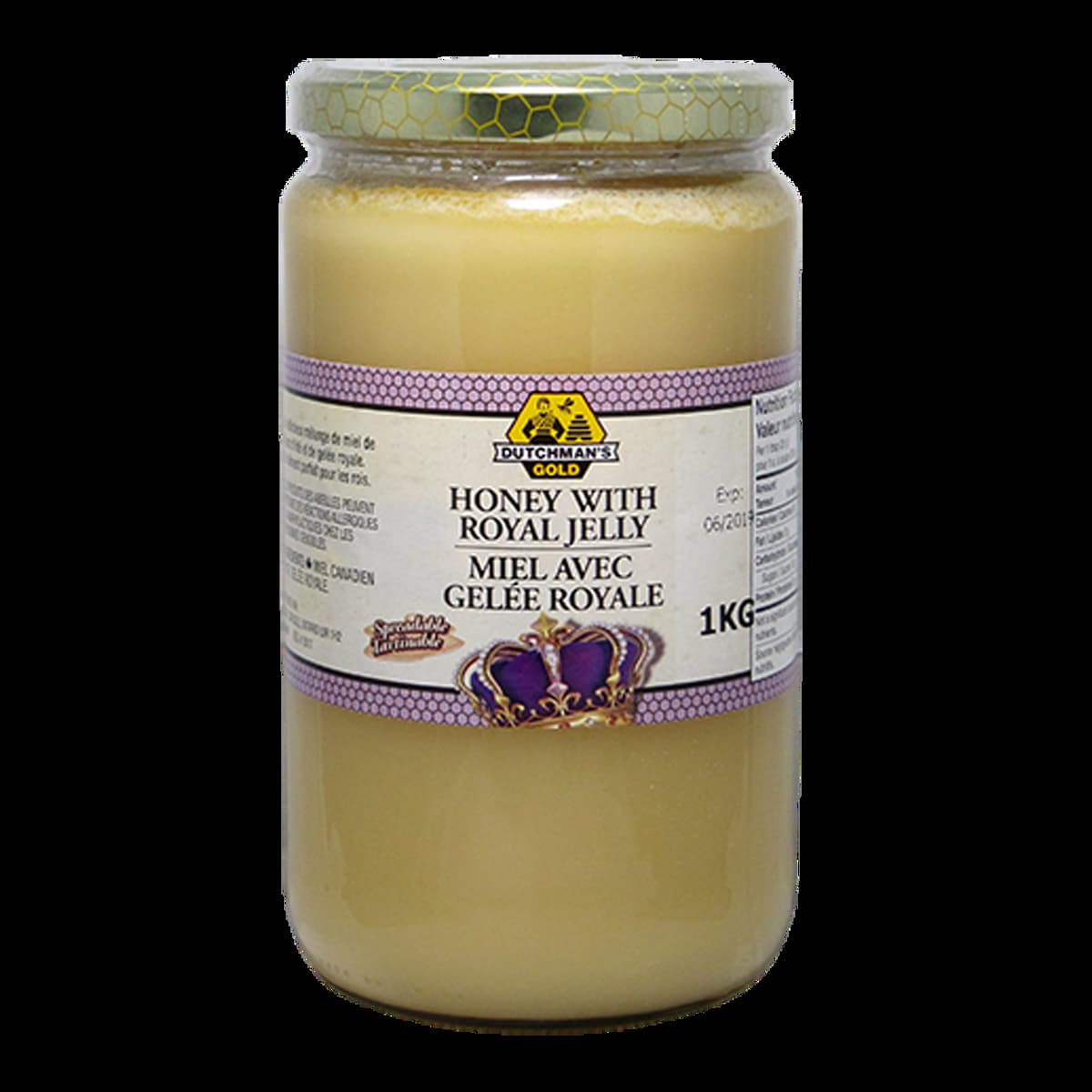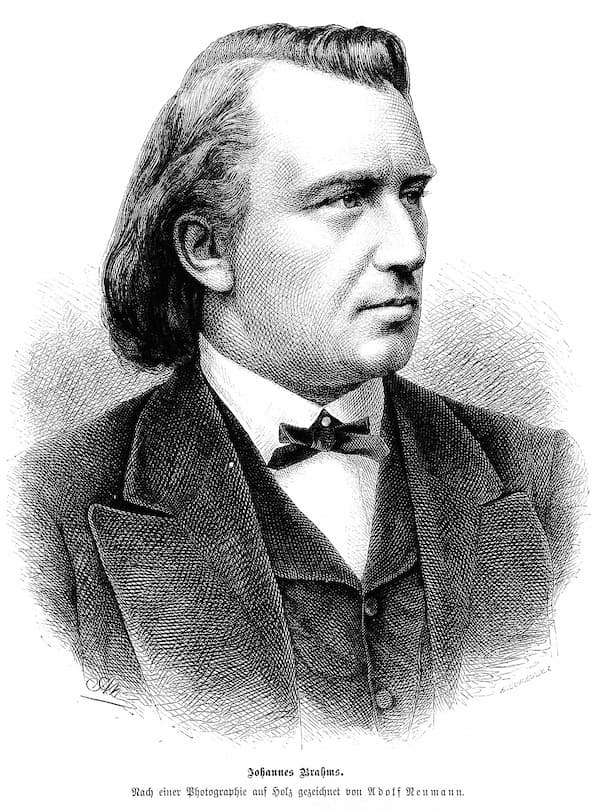Over the generations, composers have written a surprising number of pieces of classical music about bees.
Today, to celebrate World Bee Day, we’re looking at seven examples of classical music inspired by bees – and ending with an amusing bit of honey-based classical music history.

Image created by ChatGPT
The Flight of the Bumblebee by Nikolai Rimsky-Korsakov (1899-1900)
Let’s face it: this is the piece that you’re immediately thinking of! The Flight of the Bumblebee is the most famous piece of bee-related classical music ever written, by far.
The Flight of the Bumblebee was originally written as an orchestral interlude for Rimsky-Korsakov’s opera The Tale of Tsar Saltan.
In the opera, the Tsaritsa (the bride of the Tsar), has given birth to a male heir named Gvidon while the Tsar is away fighting.
The Tsaritsa’s jealous sisters sabotage the message to the Tsar, claiming that the child is not actually a child, but a monster.
Alarmed, the Tsar orders that the Tsaritsa and the monster be trapped in a barrel and sent out to sea.
Mother and son end up on a deserted island, where Gvidon shows kindness to a magical swan.
Gvidon, still devastated about the separation between him and his father, sings a lament about his situation.
The magical swan comes upon a solution: to turn him into a bumblebee who will fly over the ocean to see his human father.
Rimsky-Korsakov evokes this flight over the ocean with this frenetic orchestral interlude.
The Tale of Tsar Saltan was premiered in 1900 in Moscow.
“The Bee” by François Schubert (1860)
No, François Schubert was not the Franz Schubert. Rather, he was François Schubert, who was born in 1808 and died in 1878 in Dresden.
He was a violinist, and he performed for fifty years in the Staatskapelle Dresden, one of the world’s oldest orchestras.
In between performing, he also composed a variety of concert pieces and chamber music.
His most famous piece by far is this little perpetuum mobile for violin and orchestra called L’Abeille, or The Bee. It appeared as part of a collection of twelve Bagatelles.
“It was a time when silly Bees could speake” by John Dowland (1603)
John Dowland was an English Renaissance composer who lived from approximately 1563 to 1626. He was famous for his melancholy songs for lute and voice.
His song “It was a time when silly Bees could speake” was part of a collection of twenty-one songs published in 1603 as his Third and Last Booke of Songs or Aires.
The song’s lyrics were written by Robert Devereux, the Earl of Essex, who was prominent in the court of Queen Elizabeth, and a patron of Dowland.
During the Nine Years’ War, the Earl fumbled a military campaign in Ireland. In 1601, he led a coup against the queen and was beheaded.
When Dowland’s collection of songs came out, the Earl’s authorship was, understandably, not mentioned!
The song is an artful complaint:
It was a time when silly bees could speak,
And in that time I was a silly bee,
Who fed on time [or thyme, a favorite bee food] until my heart ’gan break,
Yet never found the time would favour me.
Of all the swarm I only did not thrive,
Yet brought I wax and honey to the hive.
“Where the bee sucks” by Thomas Arne (1746)
Shakespeare wrote these lyrics in The Tempest:
Where the bee sucks, there suck I:
In a cowslip’s bell I lie;
There I couch when owls do cry.
On the bat’s back I do fly
After summer merrily.
Merrily, merrily shall I live now
Under the blossom that hangs on the bough.
English composer Thomas Arne set this Shakespearean excerpt to music, and the score appears in his Lyric Harmony, Vol. 2, which was published in 1746.
Arne was born in 1710 and died in 1778. You probably know him best as the composer of O, Britannia.
Etude in F Minor (The Bees), Op. 25, No. 2 by Frederic Chopin (early 1830s)
This brief etude is an elegant evocation of a very genteel swarm of bees. It’s part of a set of etudes collected and published in 1837.
A main technical challenge of this etude is its polyrhythm: i.e., there are eighth note triplets in the right hand and quarter note triplets in the left hand. This can be a difficult rhythmic pattern to perform, and requires skilled coordination between the hands.
Interestingly, Johannes Brahms later rewrote this etude to make it more difficult, adding in some rather extraneous thirds and sixths. Lots of listeners dislike what Brahms did here, but putting aside its clunky sound, it’s certainly a great etude to use while studying thirds and sixths!
Chopin-Brahms: Etude Op. 25 No. 2
Bee-Sharp Honeybee by Rae Howell (2014)
In 2014, Rae Howell left her native Australia to travel to Minnesota to record some music. The recording engineer had beehives in his backyard, and she was fascinated.
She told Classical MPR, “I started to plan a project around [the hives], working with beekeepers, the same engineer [Jared Miller], a string quartet, and got in contact with the University of Minnesota Bee Research Lab about the possibility of collaborating on an event of some sort.”
The University of Minnesota was excited to collaborate, and the result was the work Bee-Sharp Honeybee. The work consists of thirteen miniatures, all directly inspired by the bees’ buzzes.
Since its initial composition, the scope of the work has snowballed. Howell eventually turned Bee-Sharp, Honeybee into a whole work for string orchestra, animated projections, and even a live hive.
Bee-Sharp Honeybee Music Project: for String Orchestra, Animations and Live Honeybees
Scherzo Fantastique by Igor Stravinsky (1907-08)
Igor Stravinsky was in his mid-twenties and just beginning his compositional career when he read an essay by writer Maurice Maeterlinck called “La Vie des Abeilles” (“The Life of Bees”).
He began working on a scherzo inspired by bees in the summer of 1907 and finished it in March 1908. He showed it to his teacher – none other than Nikolai Rimsky-Korsakov! – who liked it, but who died a few months later, before the work was actually premiered.
The Scherzo Fantastique’s premiere was given in February 1909, along with another early Stravinsky work, Feu d’artifice.
One audience member was especially impressed: ballet impresario Serge Diaghilev. Diaghilev commissioned Stravinsky to write ballet music for him.
The Firebird soon followed, and Petrushka, and The Rite of Spring…and twentieth-century music would never be the same!
A Sweet Coda

Royal jelly honey
As an amusing coda to this list of bee-themed music…
Stravinsky had an intense love of honey. He’d actually bring his own jars of the stuff to restaurants!
Stravinsky and Rachmaninoff had a rocky relationship. (Stravinsky famously described Rachmaninoff as “a six-foot scowl.”)
In the 1940s, however, after the two had moved to America during World War II, Rachmaninoff wanted to make an overture of friendship, but was unsure how. Eventually, after Rachmaninoff found out about Stravinsky’s love of honey, he showed up one night at Stravinsky’s house, jar of honey in hand.
From the Flight of the Bumblebee to the exchange of honey between socially awkward composers, we hope you’ve enjoyed this collection of classical music about bees!
For more of the best in classical music, sign up for our E-Newsletter


